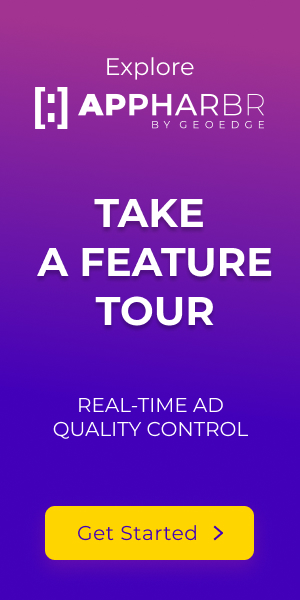There’s no denying that autoplay ads are a powerful way to capture user attention on websites and apps. On one hand, autoplay ads on mobile devices are the golden ticket to grabbing users’ attention in a flash. But on the other hand, they can be like an uninvited guest, crashing in and disrupting the experience.
How can publishers deal with disruptive advertising, including autoplay ads that benefit advertisers but destroy the in-app user experience? Learn how app developers and networks can manage autoplay audio ads at scale and prevent disruptive ads from reaching users.
Why do ads play videos and sound randomly?
“Autoplay media ads” refer to a video format advertisers commonly implement in mobile apps. These ads usually play sound automatically without requiring any user action.”
Video that begins playing instantly when a user interacts with an app is considered autoplay, whereas if the user has to click a play button, it is manual play. We should differentiate between two types of auto-playing sound ads:
- Sound placed in banners without any video element.
- Video ads that do not respect the auto-mute request from the publisher.
These ads cover the interface of their host app and are typically displayed in full-screen mode. They appear random, showing at various points within the app’s flow, such as between activities or during a pause between game levels.
What are the advantages of autoplay ads?
Mobile autoplay ads help advertisers push their message to their audiences. Simply put, advertisers want viewers to hear their message. Advantages of autoplay ads for advertisers include:
- High visibility: These ads are difficult to ignore and easily grab users’ attention.
- Increased engagement: Since autoplay ads start playing automatically, they can increase user engagement and encourage them to interact with the ad.
- Improved conversion rates: With increased engagement, these ads may result in higher conversion rates than ads requiring user interaction.
Publishers may experience some pressure to implement autoplay from agencies focused on maintaining high viewability metrics. However, click-to-play or click-for-sound ad formats could be considered to provide a superior user experience since they indicate that the audience intends to view the content if they click.The autoplay approach contrasts with click-and-play videos wherein the video will only start when a viewer clicks on the play button.
What are the disadvantages of autoplay audio ads?
Annoying video ads that play sound and disallow users to skip the ads greatly impact in-app engagement metrics.
Ads that force audio only benieft advertisers and offer minimal advantages to publishers. First and foremost, When it comes to app design, auto-playing sound can be a nuisance as it clashes with the app’s intended audio experience. App developers often take great care in creating their own sounds, only to have them interrupted by outside noise. Conflicting sounds can frustrate app developers and hinder the user’s overall experience. These ads can also cause excessive data usage and battery drain on phones.These ads can also cause excessive data usage and battery drain on phones.
Autoplay ads benefit advertisers exclusively, while users suffer from a poor experience and publishers face negative feedback and reviews on the app store.
Stop mobile ads from automatically playing audio
Although browsers and mediation networks offer some mechanisms to control ad behavior, they don’t provide an effective way for app publishers to enforce mute on autoplay video ads.
There’s no question that ads that play automatically with sound are not ideal. So, what can be done to prevent the sound auto-playing phenomenon?
Mediation networks like Admob, Applovin, and Ironsource don’t offer an efficient solution. Although they provide notifications about unwanted ads, mediations don’t include real-time protection or a dedicated feature for muting sound on ads. Even with the notifications, the network that serves the ad needs to know its ID in order to block it, and mediation solutions can’t always provide ad IDs. Even when the ID is found, it’s only possible to block the campaign of unwanted video ads on the network that served it.
In short, to block auto-playing video ads with sound through a mediation network, you have to do the following:
- “Catch” the ad so you can log it and extract its ID.
- Block the ad ID in the dashboard of your ad solution (in most cases, this is possible only if the ad came from the mediation network’s direct demand).
- If the ad is from a mediated network, you’ll have to send the ID to that network and ask them to block it or ask the mediation solution to take action to ensure better ads.
Preventing autoplay audio ads on Android and iOS with AppHarbr
If audio and video play automatically, publishers can mute all programmatic creatives displayed in-app by integrating AppHarbr’s real-time ad quality SDK.
Since auto sound ads negatively impact user engagement, it’s important for developers to identify and control all disruptive advertising. Publishers don’t have to block blunt ads, as the SDK can provide real-time control to enforce mute. This can be achieved by enforcing mute across all autoplay sound ads within AppHarbr’s UI. AppHarbr’s auto-mute feature seamlessly ensures protection across all devices.
Eliminate the hassle of pinpointing the ad ID, going to each network, and requesting to block specific ads. This tool provides real-time control across demand sources,enabling you to set predefined mute rules, or receive a notification whenever one is detected so that you can decide whether or not to block it.
AppHarbr In-App Ad Quality Control
As mobile app usage increases, publishers must take control of ad quality to ensure a positive user experience. By utilizing an ad quality SDK, publishers can effectively block ads and prevent media autoplay. This not only enhances user satisfaction but also boosts engagement metrics.
To effectively monetize campaigns, be sure to implement AppHarbr’s real-time controls that allow you to:
- Set a maximum time limit for interstitials: Automatically close ads after a predefined time that aligns with industry regulations and your user experience.
- Enforce Auto-play audio control: Enforce mute across disruptive ads in real-time, ensuring an undisrupted experience.
- Gain actionable data and reporting: Gain insight into skippability of ads that appear in your app, including the median duration of ads by format and the percentage of ads that were not closed by the creative.




